Answers to Selected Exercises and Programming Projects
The following links lead to answers to selected exercises and
programming projects from the second edition of
C Programming: A
Modern Approach. Exercises and projects for which answers are
provided are marked with a icon in the book.
Note: These exercises and projects were originally the even-numbered
exercises in the first edition. (The first edition did not
distinguish between exercises and programming projects.) For the
benefit of readers who have the first edition, the original exercise
number is given in square brackets. For example, the notation [was
#4] indicates that the number of the exercise (or programming
project) was 4 in the first edition. If an answer is different
because of second-edition changes, the word "modified" will appear
inside the brackets: [was #4; modified].
Please email me with comments and error reports.
Chapter 2
Answers to Selected Exercises
2. [was #2] (a) The program contains one directive (#include) and
four statements (three calls of printf and one return).
(b)
Parkinson's Law:
Work expands so as to fill the time
available for its completion.
3. [was #4]
#include
int main(void)
�
{
int height = 8, length = 12, width = 10, volume;
volume = height * length * width;
printf("Dimensions: %dx%dx%d\n", length, width, height);
printf("Volume (cubic inches): %d\n", volume);
printf("Dimensional weight (pounds): %d\n", (volume + 165) / 166);
return 0;
}
4. [was #6] Here's one possible program:
#include
int main(void)
{
int i, j, k;
float x, y, z;
printf("Value of i: %d\n", i);
printf("Value of j: %d\n", j);
printf("Value of k: %d\n", k);
printf("Value of x: %g\n", x);
printf("Value of y: %g\n", y);
printf("Value of z: %g\n", z);
return 0;
}
When compiled using GCC and then executed, this program produced the
following output:
Value of i: 5618848
Value of j: 0
Value of k: 6844404
Value of x: 3.98979e-34
Value of y: 9.59105e-39
Value of z: 9.59105e-39
The values printed depend on many factors, so the chance that you'll
get exactly these numbers is small.
5. [was #10] (a) is not legal because 100_bottles begins with a
digit.
8. [was #12] There are 14 tokens: a, =, (, 3, *, q, -, p, *, p, ),
/, 3, and ;.
�
Answers to Selected Programming Projects
4. [was #8; modified]
#include
int main(void)
{
float original_amount, amount_with_tax;
printf("Enter an amount: ");
scanf("%f", &original_amount);
amount_with_tax = original_amount * 1.05f;
printf("With tax added: $%.2f\n", amount_with_tax);
return 0;
}
The amount_with_tax variable is unnecessary. If we remove it, the
program is slightly shorter:
#include
int main(void)
{
float original_amount;
printf("Enter an amount: ");
scanf("%f", &original_amount);
printf("With tax added: $%.2f\n", original_amount * 1.05f);
return 0;
}
Copyright © 2008, 1996 W. W. Norton & Company, Inc. All rights
reserved.
Chapter 3
Answers to Selected Exercises
2. [was #2]
(a) printf("%-8.1e", x);
(b) printf("%10.6e", x);
(c) printf("%-8.3f", x);
�
(d) printf("%6.0f", x);
5. [was #8] The values of x, i, and y will be 12.3, 45, and .6,
respectively.
Answers to Selected Programming Projects
1. [was #4; modified]
#include
int main(void)
{
int month, day, year;
printf("Enter a date (mm/dd/yyyy): ");
scanf("%d/%d/%d", &month, &day, &year);
printf("You entered the date %d%.2d%.2d\n", year, month, day);
return 0;
}
3. [was #6; modified]
#include
int main(void)
{
int prefix, group, publisher, item, check_digit;
printf("Enter ISBN: ");
scanf("%d-%d-%d-%d-%d", &prefix, &group, &publisher, &item, &check_digit);
printf("GS1 prefix: %d\n", prefix);
printf("Group identifier: %d\n", group);
printf("Publisher code: %d\n", publisher);
printf("Item number: %d\n", item);
printf("Check digit: %d\n", check_digit);
/* The five printf calls can be combined as follows:
printf("GS1 prefix: %d\nGroup identifier: %d\nPublisher code: %d\nItem number:
%d\nCheck digit: %d\n",
prefix, group, publisher, item, check_digit);
*/
return 0;
}
�
Copyright © 2008, 1996 W. W. Norton & Company, Inc. All rights
reserved.
Chapter 4
Answers to Selected Exercises
2. [was #2] Not in C89. Suppose that i is 9 and j is 7. The value of
(-i)/j could be either –1 or –2, depending on the implementation. On
the other hand, the value of -(i/j) is always –1, regardless of the
implementation. In C99, on the other hand, the value of (-i)/j must
be equal to the value of -(i/j).
9. [was #6]
(a) 63 8
(b) 3 2 1
(c) 2 -1 3
(d) 0 0 0
13. [was #8] The expression ++i is equivalent to (i += 1). The value
of both expressions is i after the increment has been performed.
Answers to Selected Programming Projects
2. [was #4]
#include
int main(void)
{
int n;
printf("Enter a three-digit number: ");
scanf("%d", &n);
printf("The reversal is: %d%d%d\n", n % 10, (n / 10) % 10, n / 100);
return 0;
}
Copyright © 2008, 1996 W. W. Norton & Company, Inc. All rights
reserved.
�
Chapter 5
Answers to Selected Exercises
2. [was #2]
(a) 1
(b) 1
(c) 1
(d) 1
4. [was #4] (i > j) - (i < j)
6. [was #12] Yes, the statement is legal. When n is equal to 5, it
does nothing, since 5 is not equal to –9.
10. [was #16] The output is
onetwo
since there are no break statements after the cases.
Answers to Selected Programming Projects
2. [was #6]
#include
int main(void)
{
int hours, minutes;
printf("Enter a 24-hour time: ");
scanf("%d:%d", &hours, &minutes);
printf("Equivalent 12-hour time: ");
if (hours == 0)
printf("12:%.2d AM\n", minutes);
else if (hours < 12)
printf("%d:%.2d AM\n", hours, minutes);
else if (hours == 12)
printf("%d:%.2d PM\n", hours, minutes);
else
printf("%d:%.2d PM\n", hours - 12, minutes);
return 0;
}
4. [was #8; modified]
#include
�
int main(void)
{
int speed;
printf("Enter a wind speed in knots: ");
scanf("%d", &speed);
if (speed < 1)
printf("Calm\n");
else if (speed <= 3)
printf("Light air\n");
else if (speed <= 27)
printf("Breeze\n");
else if (speed <= 47)
printf("Gale\n");
else if (speed <= 63)
printf("Storm\n");
else
printf("Hurricane\n");
return 0;
}
6. [was #10]
#include
int main(void)
{
int check_digit, d, i1, i2, i3, i4, i5, j1, j2, j3, j4, j5,
first_sum, second_sum, total;
printf("Enter the first (single) digit: ");
scanf("%1d", &d);
printf("Enter first group of five digits: ");
scanf("%1d%1d%1d%1d%1d", &i1, &i2, &i3, &i4, &i5);
printf("Enter second group of five digits: ");
scanf("%1d%1d%1d%1d%1d", &j1, &j2, &j3, &j4, &j5);
printf("Enter the last (single) digit: ");
scanf("%1d", &check_digit);
first_sum = d + i2 + i4 + j1 + j3 + j5;
second_sum = i1 + i3 + i5 + j2 + j4;
total = 3 * first_sum + second_sum;
if (check_digit == 9 - ((total - 1) % 10))
printf("VALID\n");
else
printf("NOT VALID\n");
�
return 0;
}
10. [was #14]
#include
int main(void)
{
int grade;
printf("Enter numerical grade: ");
scanf("%d", &grade);
if (grade < 0 || grade > 100) {
printf("Illegal grade\n");
return 0;
}
switch (grade / 10) {
case 10:
case 9: printf("Letter grade: A\n");
break;
case 8: printf("Letter grade: B\n");
break;
case 7: printf("Letter grade: C\n");
break;
case 6: printf("Letter grade: D\n");
break;
case 5:
case 4:
case 3:
case 2:
case 1:
case 0: printf("Letter grade: F\n");
break;
}
return 0;
}
Copyright © 2008, 1996 W. W. Norton & Company, Inc. All rights
reserved.
�
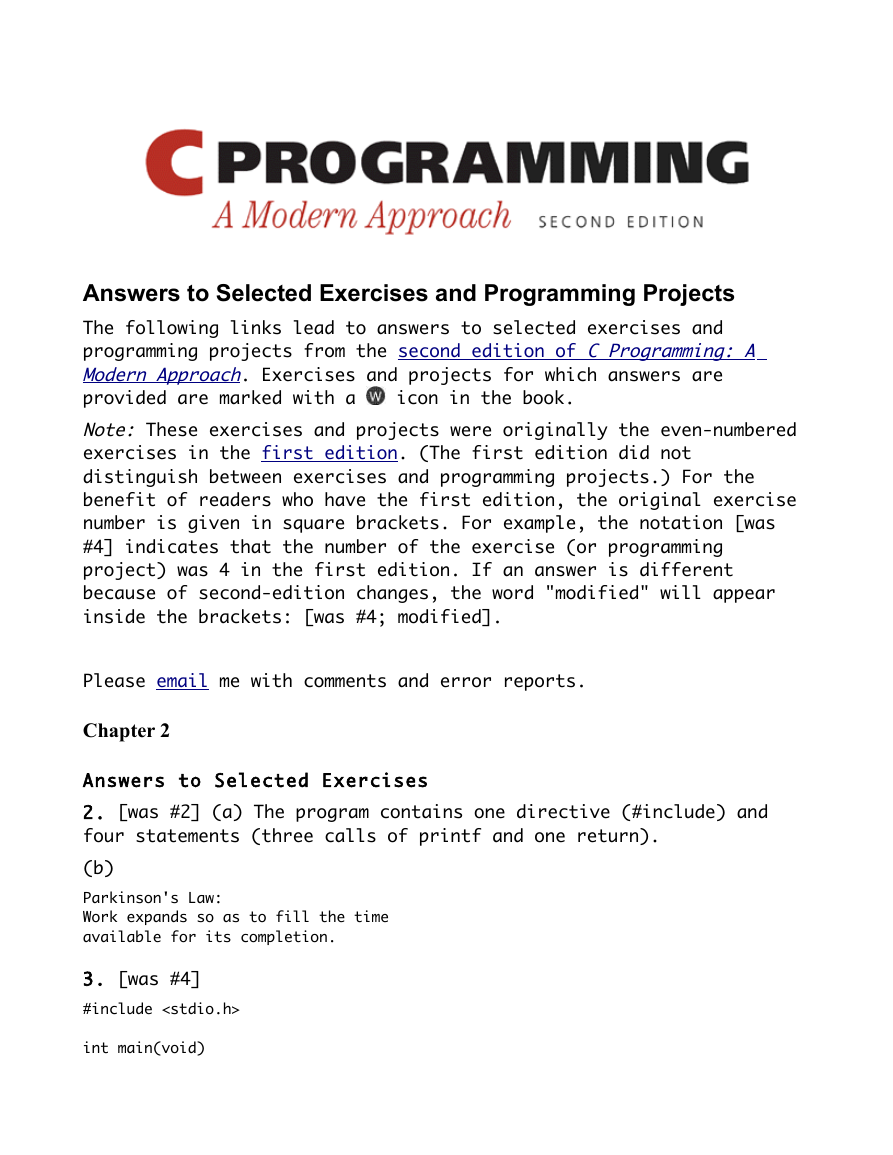
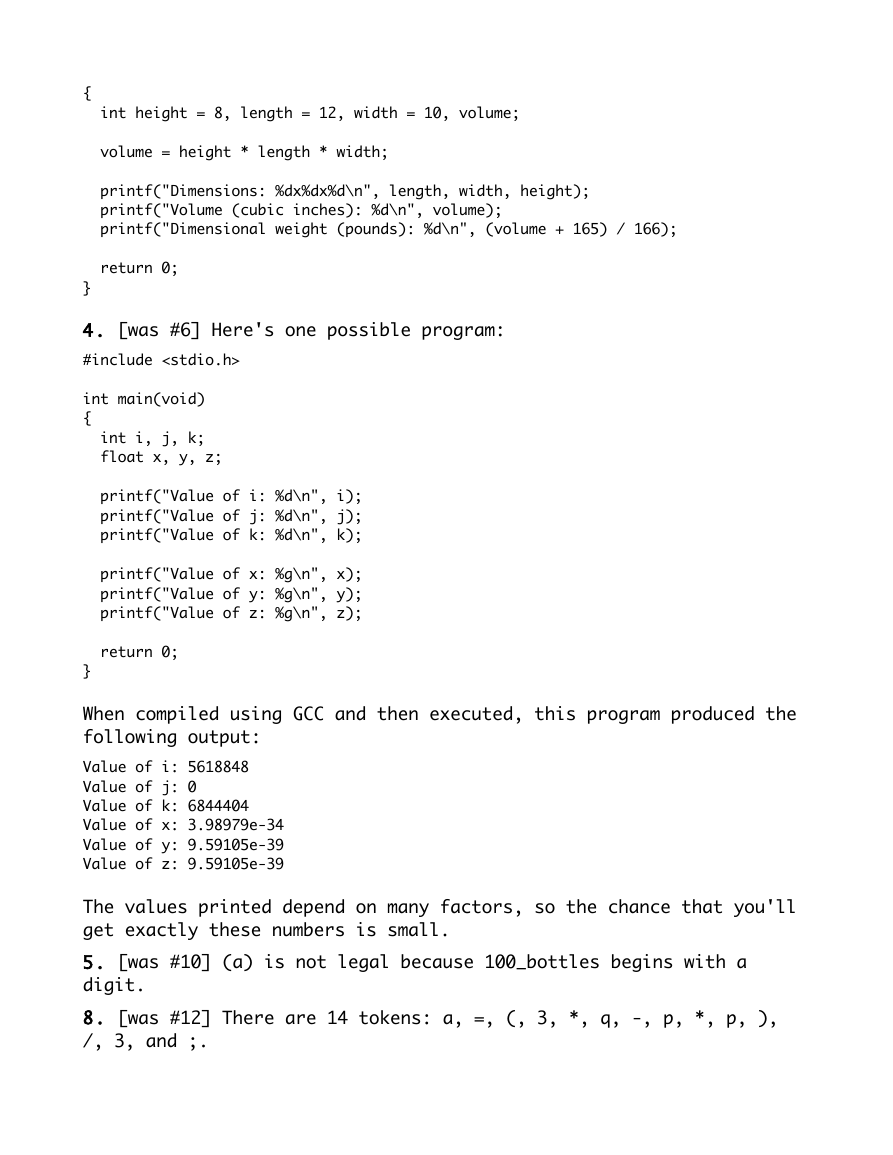
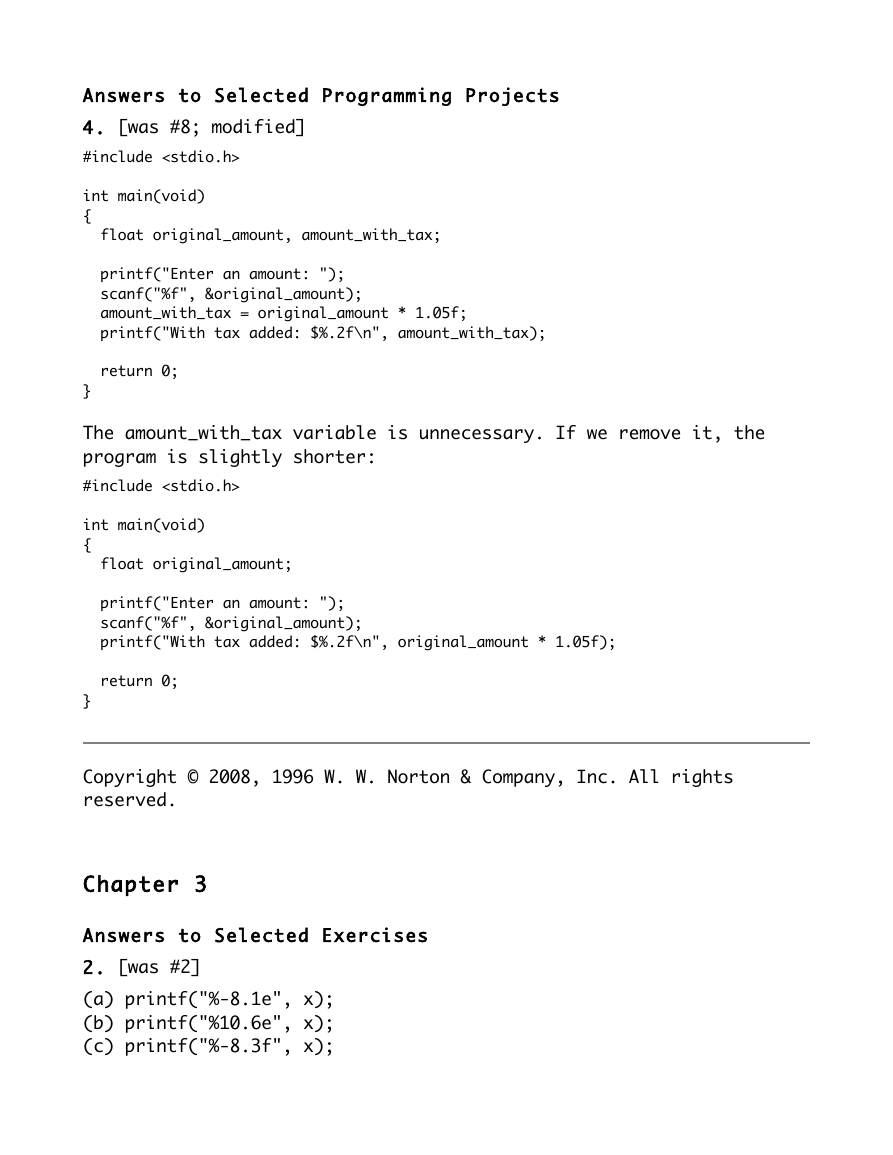
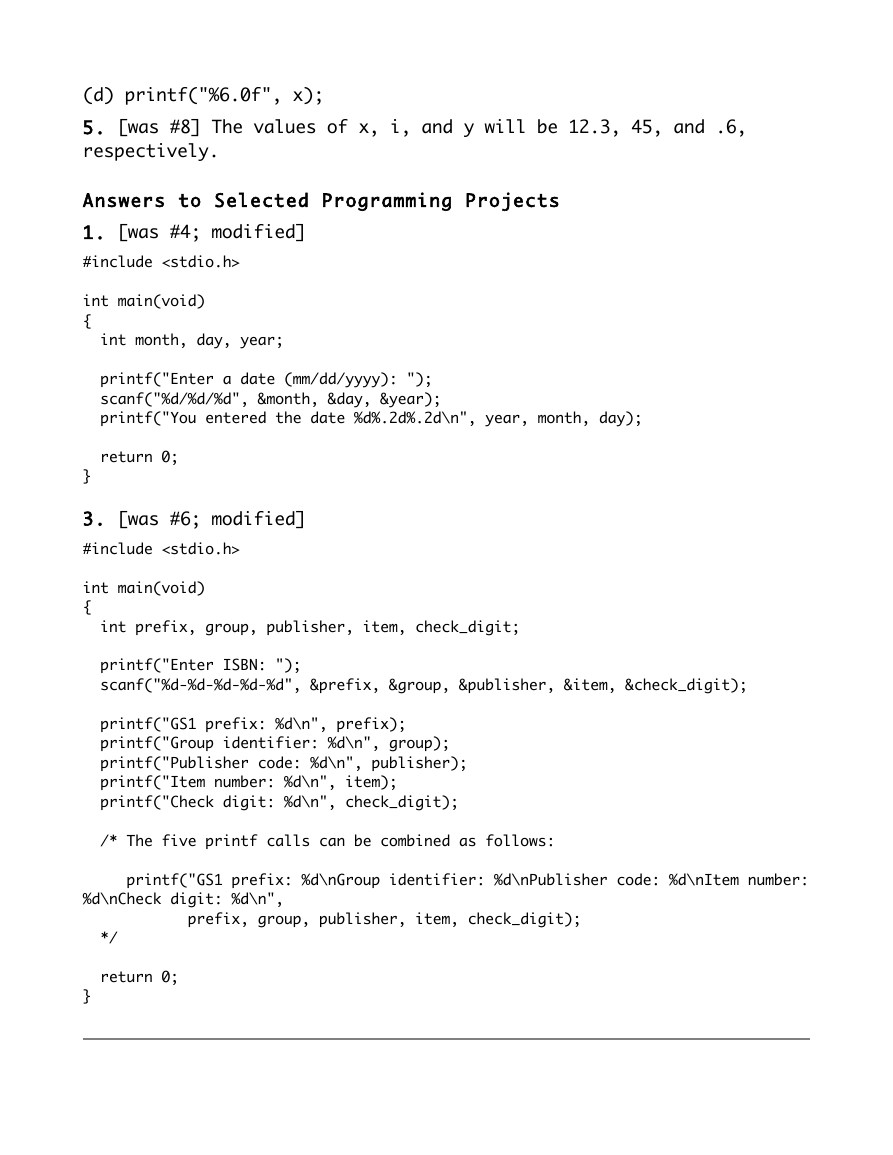
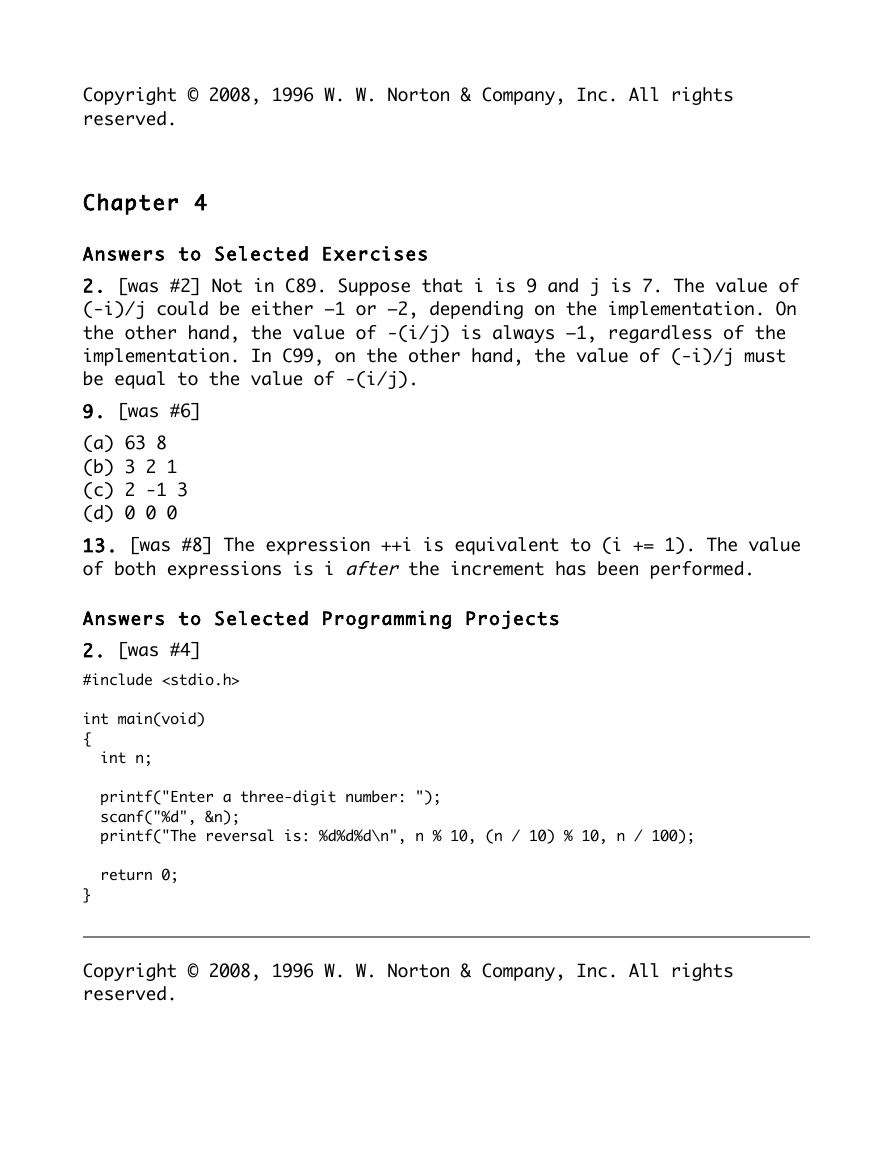
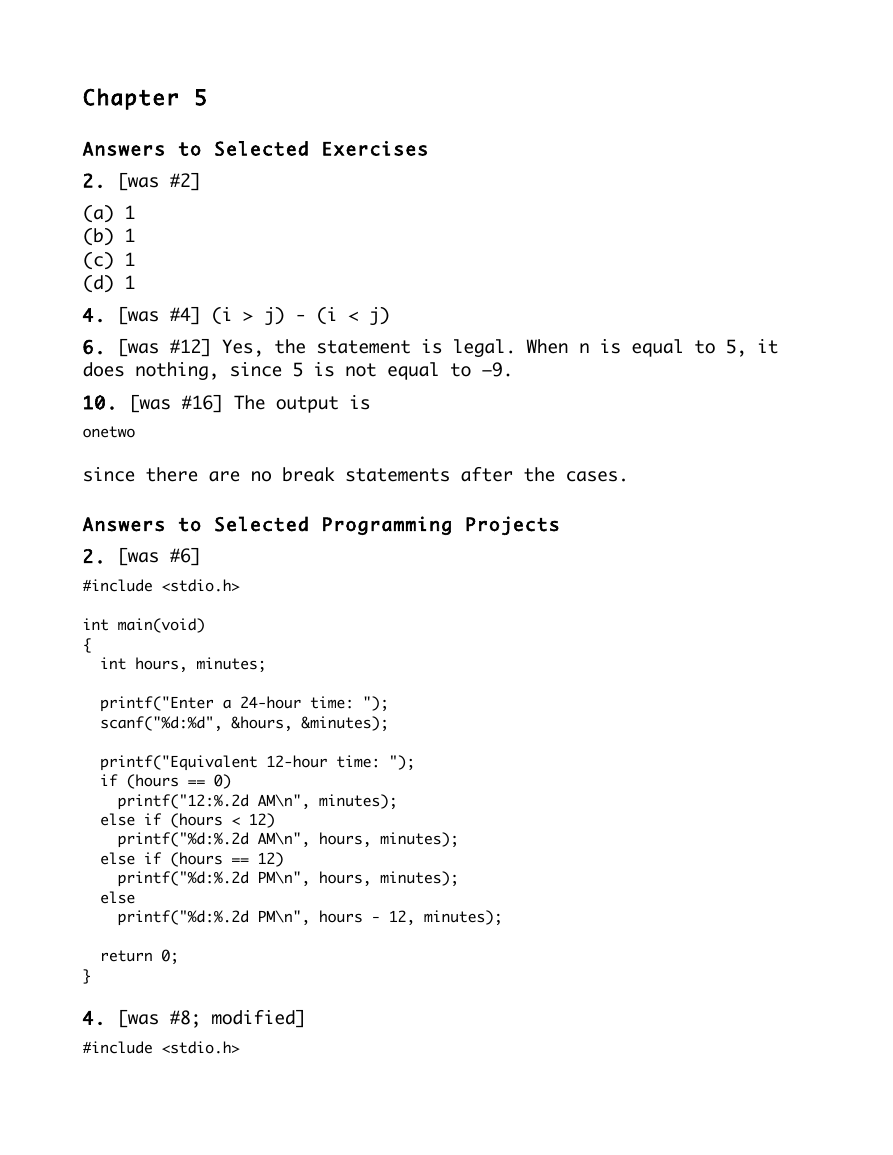
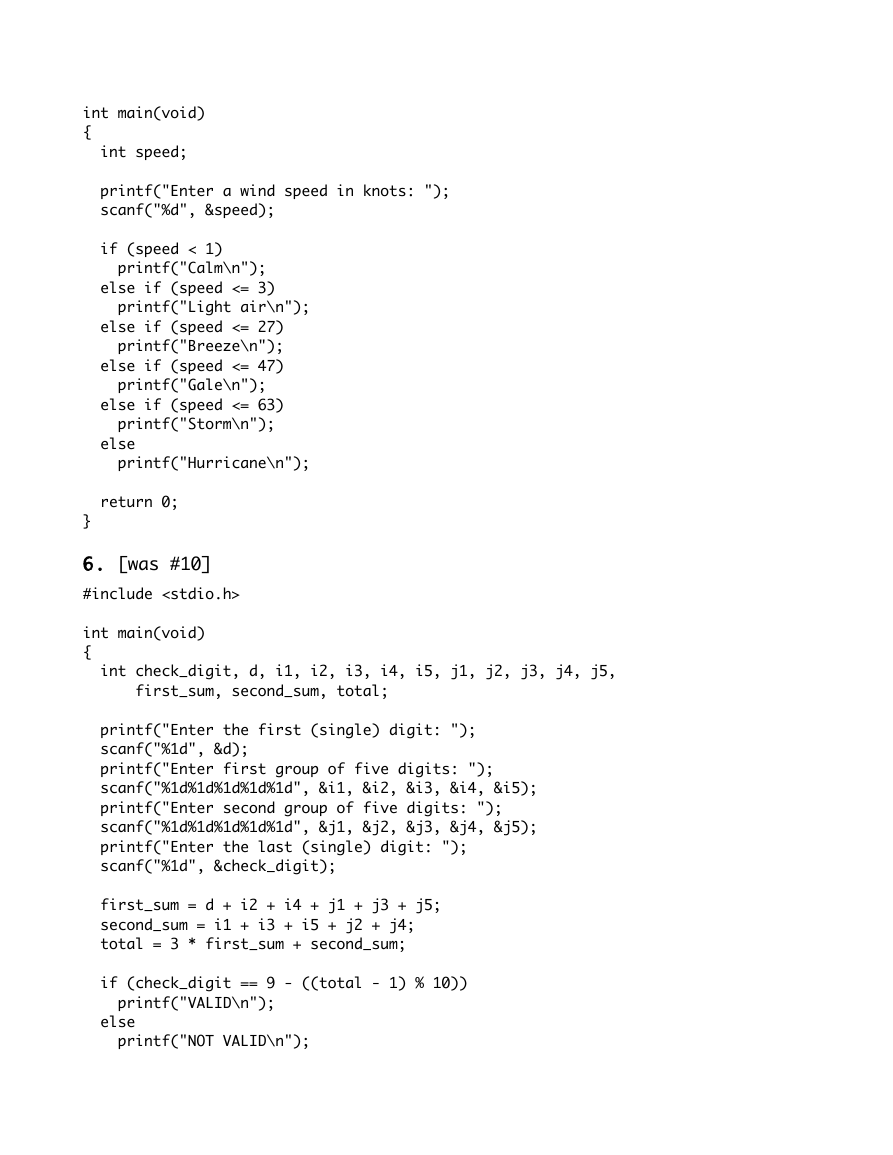
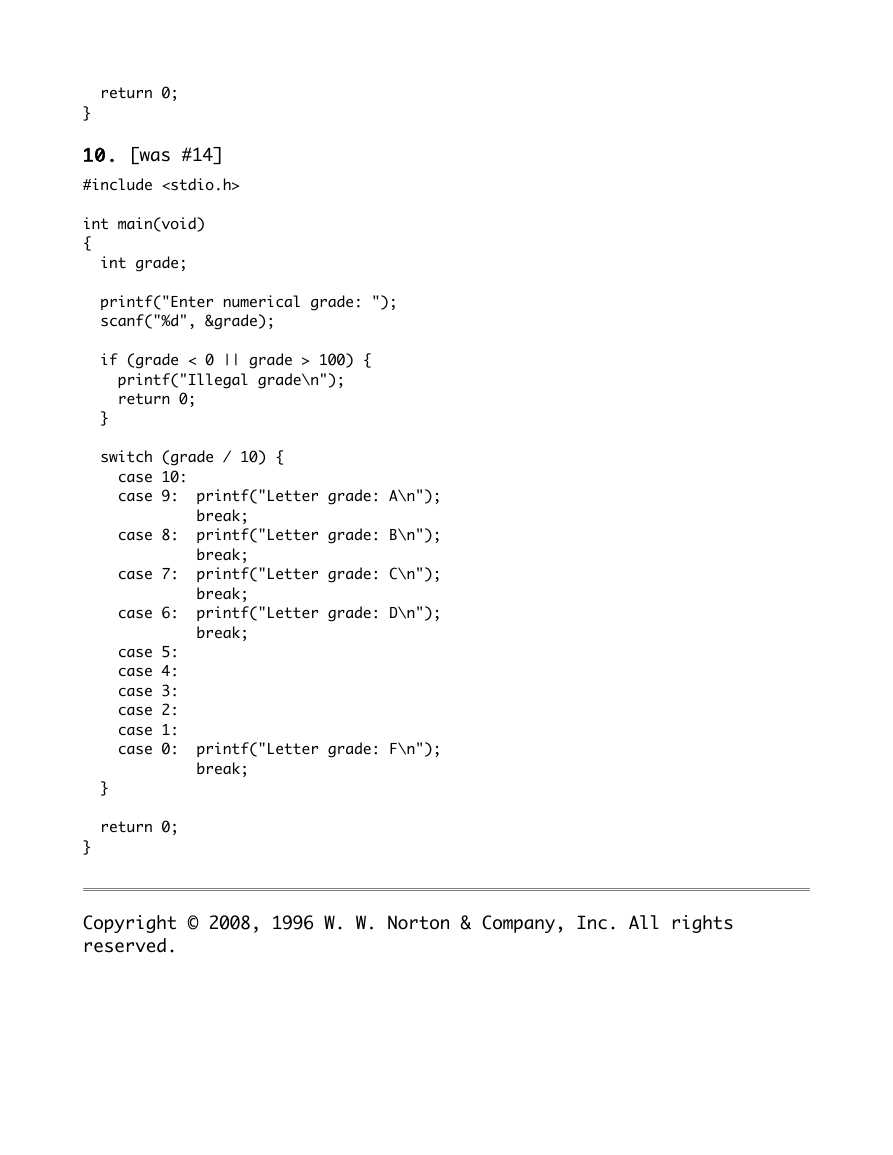








 2023年江西萍乡中考道德与法治真题及答案.doc
2023年江西萍乡中考道德与法治真题及答案.doc 2012年重庆南川中考生物真题及答案.doc
2012年重庆南川中考生物真题及答案.doc 2013年江西师范大学地理学综合及文艺理论基础考研真题.doc
2013年江西师范大学地理学综合及文艺理论基础考研真题.doc 2020年四川甘孜小升初语文真题及答案I卷.doc
2020年四川甘孜小升初语文真题及答案I卷.doc 2020年注册岩土工程师专业基础考试真题及答案.doc
2020年注册岩土工程师专业基础考试真题及答案.doc 2023-2024学年福建省厦门市九年级上学期数学月考试题及答案.doc
2023-2024学年福建省厦门市九年级上学期数学月考试题及答案.doc 2021-2022学年辽宁省沈阳市大东区九年级上学期语文期末试题及答案.doc
2021-2022学年辽宁省沈阳市大东区九年级上学期语文期末试题及答案.doc 2022-2023学年北京东城区初三第一学期物理期末试卷及答案.doc
2022-2023学年北京东城区初三第一学期物理期末试卷及答案.doc 2018上半年江西教师资格初中地理学科知识与教学能力真题及答案.doc
2018上半年江西教师资格初中地理学科知识与教学能力真题及答案.doc 2012年河北国家公务员申论考试真题及答案-省级.doc
2012年河北国家公务员申论考试真题及答案-省级.doc 2020-2021学年江苏省扬州市江都区邵樊片九年级上学期数学第一次质量检测试题及答案.doc
2020-2021学年江苏省扬州市江都区邵樊片九年级上学期数学第一次质量检测试题及答案.doc 2022下半年黑龙江教师资格证中学综合素质真题及答案.doc
2022下半年黑龙江教师资格证中学综合素质真题及答案.doc